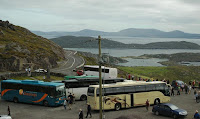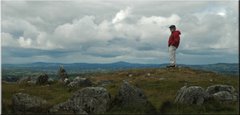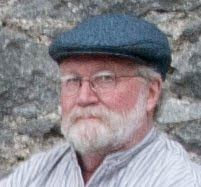Harringtons' Ireland Pictures of the Day: Conclusion
==========================================
Monday, August 28
The Long Journey Home
==========================================
Monday, August 28
The Long Journey Home
It happened just as we were about to leave our hotel room, headed for the airport.
I had my camera slung over one shoulder and our laptop computer over the other. As Diane opened the door to the hall, I noticed some change on the nightstand that I had forgotten. As I turned around quickly to go to retrieve it, my feet got tangled in a bedsheet on the floor. In that awful, dumb instant between tripping and hitting the floor, I realized that I could cushion the blow to only one of these three things: the computer, the camera, or my face.
Instinctively, I made the only rational decision.
My face was a mess for the entire journey home: I had a great, bloody gouge on my left cheek and my glasses were badly askew, even though I did my best to bend them back into at least wearable shape. I frightened small children across eight time zones. The camera fared less well; the bayonet mount on the wonderful zoom lens was broken beyond repair. That left only the telephoto long lens, and that was packed away in luggage. So we have no pictures from this last day. That's probably just as well, given how my face looked.
So, in place of pictures today, here's a map (which has to be clicked on and viewed at much higher resolution to be meaningful):

That's a Google Earth image of Ireland with our driving history superimposed on it. If you've been following along, the places marked on the map will mean something more to you now than they would have if I'd presented it earlier on.
Now that more than a year has passed since our... I don't know what to call it. Vacation? No, it was more than that, much more. Adventure? No, not really, at least in a dramatic sense. Education? Too dry. I don't know; there are professional wordsmiths who read this thing, though, and they might be able to help me out.
Anyway, now that more than a year has passed since our whatever-it-was, it's time for me to put Ireland away, at least as far as this blog is concerned. And I will, but first just some random things:
I had my camera slung over one shoulder and our laptop computer over the other. As Diane opened the door to the hall, I noticed some change on the nightstand that I had forgotten. As I turned around quickly to go to retrieve it, my feet got tangled in a bedsheet on the floor. In that awful, dumb instant between tripping and hitting the floor, I realized that I could cushion the blow to only one of these three things: the computer, the camera, or my face.
Instinctively, I made the only rational decision.
My face was a mess for the entire journey home: I had a great, bloody gouge on my left cheek and my glasses were badly askew, even though I did my best to bend them back into at least wearable shape. I frightened small children across eight time zones. The camera fared less well; the bayonet mount on the wonderful zoom lens was broken beyond repair. That left only the telephoto long lens, and that was packed away in luggage. So we have no pictures from this last day. That's probably just as well, given how my face looked.
So, in place of pictures today, here's a map (which has to be clicked on and viewed at much higher resolution to be meaningful):

That's a Google Earth image of Ireland with our driving history superimposed on it. If you've been following along, the places marked on the map will mean something more to you now than they would have if I'd presented it earlier on.
Now that more than a year has passed since our... I don't know what to call it. Vacation? No, it was more than that, much more. Adventure? No, not really, at least in a dramatic sense. Education? Too dry. I don't know; there are professional wordsmiths who read this thing, though, and they might be able to help me out.
Anyway, now that more than a year has passed since our whatever-it-was, it's time for me to put Ireland away, at least as far as this blog is concerned. And I will, but first just some random things:
==========================================
Midlands 103
Midlands 103
Thank God for the internet.
We have a link on our desktop to Midlands 103, the local radio station for the Offaly/Laois/Westmeath area. We fire it up once in a while to see what's going on in the old home-away-from... and just to hear the sounds of Irish English once again. Click here to tune in, but, since news and talk tends to be most abundant during morning and evening drive times, be aware of the time difference: Ireland is four hours ahead of you if you're in New Brunswick, five if you're in Maine, Michigan, New York, or South Carolina, and eight if you're in the vicinity of Boulder Creek or Fulton, California. Just to pick a few examples completely at random, of course.
We have a link on our desktop to Midlands 103, the local radio station for the Offaly/Laois/Westmeath area. We fire it up once in a while to see what's going on in the old home-away-from... and just to hear the sounds of Irish English once again. Click here to tune in, but, since news and talk tends to be most abundant during morning and evening drive times, be aware of the time difference: Ireland is four hours ahead of you if you're in New Brunswick, five if you're in Maine, Michigan, New York, or South Carolina, and eight if you're in the vicinity of Boulder Creek or Fulton, California. Just to pick a few examples completely at random, of course.
==========================================
An Unexpected Bit of Music
Mike Peterson rightly recommended Planxty as appropriate accompaniment for much of this month's reminiscences, to which I will add the usual suspects, the Chieftains. And a good bit of the Pogues, too -- in fact, I've listened to "Thousands are Sailing" probably too many times while composing this stuff for the past few weeks. Clicking the link right at the top of this day's post will take you to another of my favorites.
But there is one uniquely appropriate recording for the Birr Castle Demesne portions of this series that we didn't find out about until we returned to California: Karin Leitner's (flute) and Duccio Lombardi's (harp) performance of a number of Irish and classical melodies on their album "The Gardens of Birr Castle Demesne." It goes especially well with this slide show.
An Unexpected Bit of Music
Mike Peterson rightly recommended Planxty as appropriate accompaniment for much of this month's reminiscences, to which I will add the usual suspects, the Chieftains. And a good bit of the Pogues, too -- in fact, I've listened to "Thousands are Sailing" probably too many times while composing this stuff for the past few weeks. Clicking the link right at the top of this day's post will take you to another of my favorites.
But there is one uniquely appropriate recording for the Birr Castle Demesne portions of this series that we didn't find out about until we returned to California: Karin Leitner's (flute) and Duccio Lombardi's (harp) performance of a number of Irish and classical melodies on their album "The Gardens of Birr Castle Demesne." It goes especially well with this slide show.
==========================================
Some Reading
While we were in Ireland (and very shortly before and after), this was our reading list (in no particular order):
 A Short History of Modern Ireland by Richard Killeen
A Short History of Modern Ireland by Richard Killeen
At Arm's Length: Aristocrats in the Republic of Ireland by Anne Chambers
Chambers's work is an insight into a little-noticed aspect of Irish society, and a little-understood one even when it is noticed. We, of course, were interested because of where we stayed and the remarkable achievements of the Parsons family, but many other families in the Irish aristocracy have fascinating histories as well. The book is described thusly on the website of the descendants of Irish Chief MacSweeny Doe: From Galaxies to Turbines: Science, Technology and the Parsons Family by W. G. S. Scaife
Whatever Shines Should Be Observed by Susan M. P. McKenna-Lawlor
This little book tells the stories of five remarkable Irishwomen who were pioneers in a variety of modern sciences and technologies. From the introduction by Alison, Countess of Rosse (the current Lady Rosse):
Some Reading
While we were in Ireland (and very shortly before and after), this was our reading list (in no particular order):
 A Short History of Modern Ireland by Richard Killeen
A Short History of Modern Ireland by Richard KilleenAt Arm's Length: Aristocrats in the Republic of Ireland by Anne Chambers
Chambers's work is an insight into a little-noticed aspect of Irish society, and a little-understood one even when it is noticed. We, of course, were interested because of where we stayed and the remarkable achievements of the Parsons family, but many other families in the Irish aristocracy have fascinating histories as well. The book is described thusly on the website of the descendants of Irish Chief MacSweeny Doe:
Anne Chambers chose fourteen Irish Chiefs and Peers representative of the Gaelic, Anglo-Norman, Elizabethan, Jacobite, Cromwellian, Williamite, Victorian and Edwardian-created aristocracy/ ruling class in Ireland and elicited their opinions on a range of issues of historical and present-day interest. She recorded the fate and fortunes of families descended from the Gaelic Chiefs she interviewed and of those who superseded them.
Whatever Shines Should Be Observed by Susan M. P. McKenna-Lawlor
This little book tells the stories of five remarkable Irishwomen who were pioneers in a variety of modern sciences and technologies. From the introduction by Alison, Countess of Rosse (the current Lady Rosse):
This book gives us the lives of these five exceptional, but little known, Irish women. They achieved high recognition in scientific subjects at a time when women in the propertied classes were hardly allowed out of the nursery before their marriage, and schooling for daughters was very much an afterthought behind the education of their brothers. These five ladies, due to their own persistence and high intelligence, taught themselves astronomy, microscopy and photography, an unusual achievement in itself. But more than theat, they were to become experts in their fields and successfully pursued these ambitions, indeed, followed their stars. Mary Rosse won the Dublin Silver Medal for Excellence for her photography. Mary Ward [a Parsons cousin -- SH] published authoritative works on astronomical subjects and microscopy and, by 1903, Margaret Huggins and Agnes Clerke were invited to become honorary members of the Royal Astronomical Society.Mary Ward has another, sadder distinction: she was Ireland's first auto accident fatality, thrown from (and run over by) a Parsons invention, the "Road Locomotive," in Birr on August 31st, 1869.
==========================================
Want to Re-Visit a HI-POD?
Just click:
Part 1: July 26 - 31, 2006
Leavin' on a Jet Plane
Near Dublin
To Birr
Birr Castle Demesne
The Slieve Bloom Mountains
Part 2: August 1 - 7, 2006
Clonmacnoise and Shannon Harbour
Clifden
The Aran Islands
Back to Birr
The Red Tree Trail
Ireland's Historic Science Centre
The Waterford Glass Factory
Part 3: August 8 - 14, 2006
To the Burren
The Cliffs of Moher
A Visit with the Earl and Countess
Loughcrew (the Hill of the Witch)
The Rock of Cashel
Birr Heritage Week Parade
Birr Castle Archives
Part 4: August 15 - 20, 2006
Carrowmore and Sligo
Rustic Connaught
The Connemara Pony Show
Through the Kylemore Pass
A Cozy Day in the Birr Castle Demesne
Birr Town and a Trip to Killarney
Part 5: August 21 - 27, 2006
The Ring of Kerry
Limping "Home"
Hunkered Down
Last Full Day in the Midlands
Back to Dublin
County Wicklow
Newgrange and Tara
All of the auxiliary slide shows on sharrington.net
are available by clicking here -- and that link will
also give you an insight into why,
really, we took and archived such a huge number
of images. It's not something we ordinarily do.
Want to Re-Visit a HI-POD?
Just click:
Part 1: July 26 - 31, 2006
Leavin' on a Jet Plane
Near Dublin
To Birr
Birr Castle Demesne
The Slieve Bloom Mountains
Part 2: August 1 - 7, 2006
Clonmacnoise and Shannon Harbour
Clifden
The Aran Islands
Back to Birr
The Red Tree Trail
Ireland's Historic Science Centre
The Waterford Glass Factory
Part 3: August 8 - 14, 2006
To the Burren
The Cliffs of Moher
A Visit with the Earl and Countess
Loughcrew (the Hill of the Witch)
The Rock of Cashel
Birr Heritage Week Parade
Birr Castle Archives
Part 4: August 15 - 20, 2006
Carrowmore and Sligo
Rustic Connaught
The Connemara Pony Show
Through the Kylemore Pass
A Cozy Day in the Birr Castle Demesne
Birr Town and a Trip to Killarney
Part 5: August 21 - 27, 2006
The Ring of Kerry
Limping "Home"
Hunkered Down
Last Full Day in the Midlands
Back to Dublin
County Wicklow
Newgrange and Tara
All of the auxiliary slide shows on sharrington.net
are available by clicking here -- and that link will
also give you an insight into why,
really, we took and archived such a huge number
of images. It's not something we ordinarily do.
==========================================
What I Would Do Differently
What I Would Do Differently
Nothing.
Now that we have a little bit of a feeling for the land, though, if there is a next time, we will spend a good deal of it in Dublin... and a spend lot more of our time with with individual people.
But for this trip? No, nothing different at all. Except maybe not go back for that change on the nightstand.
Now that we have a little bit of a feeling for the land, though, if there is a next time, we will spend a good deal of it in Dublin... and a spend lot more of our time with with individual people.
But for this trip? No, nothing different at all. Except maybe not go back for that change on the nightstand.
==========================================


















































